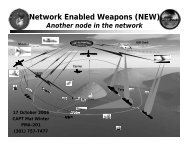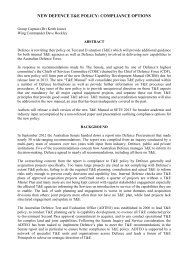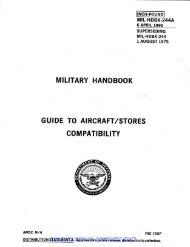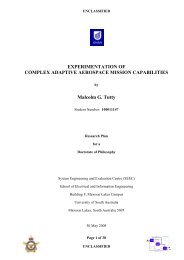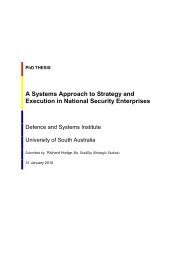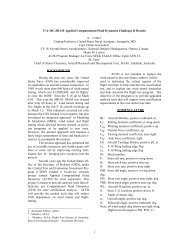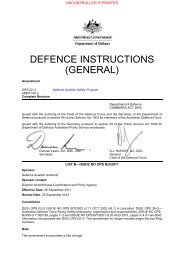NATO CRUD 2011.pdf
NATO CRUD 2011.pdf
NATO CRUD 2011.pdf
You also want an ePaper? Increase the reach of your titles
YUMPU automatically turns print PDFs into web optimized ePapers that Google loves.
eturns closest to the Shooter end without touching it or the<br />
side rails determines Choice.<br />
The Life – The term used to impose any infraction of these<br />
rules. The Life may also be called by its proper name.<br />
Infractions in “quotation marks” within these rules are Lives.<br />
“No Six” – The Shooter must personally make this call to stop<br />
the Round before taking any shot. Whenever the Object Ball is<br />
hit, it must travel 15 Centimetres (6 inches), including bumper<br />
bounce, except in the cases of the “Double Kiss, Dead." The<br />
Referee will determine the distance of travel based on his<br />
judgment of where the Object Ball was last hit. If full travel is<br />
less than 15 Centimetres (6 inches), centre-ball to centre-ball,<br />
the Life is against the last Shooter. If it travelled 15<br />
Centimetres (6 inches) or more, the Life is a Dead Ball on the<br />
Ball-in-Hand Player.<br />
The Object Ball – The Object Ball may only be touched by the<br />
Shooter Ball, and must be Pocketed or kept in motion at all<br />
times during a Round.<br />
Outer Marker – Boundary line one metre (3 feet) beyond the<br />
Inner Marker. The area between the Inner and the Outer<br />
Marker is the Holding Area where players stand awaiting their<br />
next play.<br />
Player on Deck – This player, as the next player in turn to<br />
play, is allowed on the Runway, but has no Blocking rights.<br />
“Playing Out of Turn” – A Player touching the Shooter Ball<br />
when it is not that player’s turn or any out-of-turn play detected<br />
by the Judge. Also, a Team Captain may stop a game to point<br />
this infraction out to the Referee at the risk of a Life. If verified,<br />
a Life will be assessed against the guilty Team’s Captain or its<br />
first available player. Otherwise, a Life will be assessed for<br />
stopping the Round.<br />
“Pocket” – Any time the Object Ball is hit into, and remains in,<br />
one of the pockets, i.e., centre-ball past the lip of the pocket.<br />
The Referee will determine who receives the Life based on the<br />
Judge’s opinion of whether or not the Next Shooter had ANY<br />
opportunity to influence the play with a valid shot. If the Next<br />
Shooter had a chance to influence play, the next Shooter<br />
receives the Life. Otherwise, the Life is against the previous<br />
Shooter on that team.<br />
“Push Shot” – Any stylised propelling of the Shooter Ball by<br />
the Shooter’s hand is allowed, providing the Shooter’s hands<br />
or fingers are not touching the Shooter Ball when or after the<br />
Shooter Ball makes contact with the Object Ball.<br />
The Receiver / Next Shooter —The Defender as a Round<br />
begins, and the next player after the Shooter at any point in<br />
time.<br />
The Referee –- a respected and experienced (if much<br />
maligned) character whose word is law, or it’s a Life too.<br />
“Replay” – If “Replay” is declared following a Contested<br />
Decision, teams start from the beginning of the Round in<br />
question, or if the Referee allows, Team Captains or<br />
designated Players may face off one-on-one. Choice goes to<br />
the Team that had it at the start of the Round in question.<br />
“Roughing the Referee” – No Player may make contact with<br />
or bump into the Referee so as to cause him/her the need to<br />
regain balance, composure or heaven forbid spill his drink.<br />
Round – Begins with the Service shot and ends when a Life is<br />
called, or the play is stopped for any reason.<br />
Runway – An area one metre (3 feet) wide around the <strong>CRUD</strong><br />
Table. Only the Shooter, Next Shooter, and the Player on Deck<br />
may be on the Runway at any one time. The (previous)<br />
Shooters must, without Blocking the (next) Shooter, depart the<br />
runway as quickly as possible after making their shot, except in<br />
the case where they are the Single Man.<br />
“Scratch” – During Service, the Server misses the spotted<br />
Object Ball three (3) times.<br />
The Service – The opening event of each Round. With the<br />
Object Ball spotted on the centre line 15 centimetres (6 inches)<br />
from the Receiver end of the table (typically halfway to the<br />
Snooker location spot), the Shooter is given three (3) attempts<br />
to hit the spotted Object Ball using any number of bumper<br />
bounces. Shooter Ball movement may only be stopped by the<br />
Referee or the Shooter. Any Service where the Shooter Ball<br />
goes beyond half the length of the Table will be counted as<br />
one (1) attempt.<br />
The Shooter – The Offender as a Round begins and the<br />
player with the responsibility to make the next shot before<br />
the Object Ball is called Dead or is Pocketed.<br />
The Shooter Ball – This ball, usually a cue ball, may be<br />
touched or picked up by the Receiver/Next Shooter from<br />
anywhere around the table only after it hits the Object Ball.<br />
However, it must be shot in accordance with all applicable<br />
rules herein. The Shooter may, in order to hit an Object Ball<br />
still in motion, recover the Shooter Ball - even if it goes into a<br />
pocket-- and take as many ‘shots’ as needed. All shots must<br />
be at the Object Ball and not at other Players. Accidental<br />
release or dropping of the Shooter Ball will not be held<br />
against the Shooter, unless it hits the Object Ball.<br />
The Single Man – When a Team is attrited down to one<br />
Player (of any sex), that Player has the Choice at the<br />
beginning of each Round to Receive or Serve. When both<br />
teams have only one player remaining, normal Choice rules<br />
apply. NOTE: All Blocking rules remaining in effect for<br />
Tournament Games.<br />
Substitution – Substitution may not be made without the<br />
consent of the Referee.<br />
“Unsportsmanlike Conduct” – When the Referee<br />
determines a player’s actions or language is unsuitable for<br />
the game at hand, the Referee may assess a Life or eject a<br />
player from the game or tournament.<br />
The Warning – If, in the Referee’s considered judgement, a<br />
Player makes a play that is very nearly a Life and the<br />
Referee might be inclined to assess a Life if that same play<br />
or event is committed again, the Referee may call “Warning<br />
on the Push, Blocking, etc.”<br />
“Wrong Ball” – During play, the Shooter touches the Object<br />
Ball.<br />
Traditional Concepts & Conventions:<br />
1. The losing team buys the winning team their drink of<br />
choice, usually by aligned players on the scoreboard. If the<br />
winning team has at least one “Virgin” (no Lives assessed),<br />
the Virgin’s team is entitled to two drinks of choice for that<br />
game by the losers.<br />
2. As recompense for services rendered, the first player<br />
attrited from the game buys the Referee his or her drink of<br />
choice. The next player attrited buys a drink for the<br />
Scorekeeper<br />
3. The 15 centimetre (6 inch) rule is measured by a<br />
Canadian/Australian dollar bill, now both extinct. An<br />
American dollar or a Canadian two dollar bill may be used.<br />
4. To even the number of players on a team, one team may<br />
use one or more “Ghost(s).” The Team’s Ghost receives the<br />
first three available Lives that are not any Player’s first Life,<br />
or any other agreed-upon method.<br />
5. The original <strong>CRUD</strong> Foul Line was typically a 45 degree<br />
imaginary line extending outward from each corner. <strong>NATO</strong><br />
has selected this as a more interoperable foul line to liven up<br />
the <strong>CRUD</strong> rules and make future <strong>CRUD</strong> an even more free<br />
flowing game.<br />
6. For violations of the Foul Line rules, the Referee may use<br />
the term “Balls” or “Lips”, as appropriate.<br />
7. Some 6’x12’ Snooker tables have been built without side<br />
pockets. Plugging the side pockets of <strong>CRUD</strong> Tables smaller<br />
than 6' by 12' Snooker tables is traditionally done with rolls of<br />
toilet paper. True <strong>CRUD</strong> aficionados and acolytes always<br />
use all six pockets on the 6’x12’ Snooker table.<br />
8. A Player who actually reads all these rules to try and win a<br />
point with the Referee may be assessed a Life or be obliged<br />
to buy the Referee a drink of his/her choice.<br />
Comments to <strong>NATO</strong><strong>CRUD</strong>RULES@hotmail.com<br />
See www.maltutty.com using visitor / Maven1<br />
Wing Commander Malcolm G. “Maven” Tutty, RAAF



